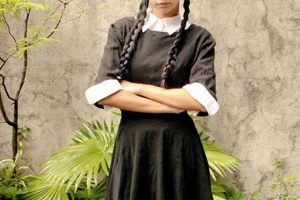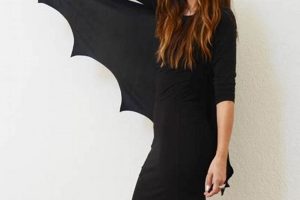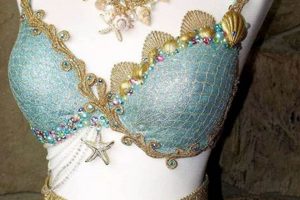Creating a Princess Jasmine-inspired outfit involves the construction of attire reminiscent of the Disney character. This process typically includes assembling or crafting a top, pants, and accessories that mirror the distinct style and color palette associated with the character. This type of project often utilizes accessible materials and commonly available sewing or crafting techniques to replicate the essence of the princess’s iconic look.
The creation of such attire offers several advantages, including cost-effectiveness compared to purchasing pre-made costumes, allowing for personalized customization to achieve a unique look and providing a creative outlet for individuals interested in design and fabrication. Historically, recreating character-based garments has been a popular activity for costume parties, theatrical productions, and themed events, reflecting a broader interest in self-expression and engaging with popular media.
The following sections will explore various methods and considerations for constructing such attire, from fabric selection and pattern adaptation to embellishment techniques and accessory design, providing a comprehensive overview of the creation process.
Tips for a Princess Jasmine-Inspired Costume
Achieving a successful Princess Jasmine-inspired look necessitates careful planning and attention to detail. The following tips offer guidance on key aspects of the construction process to ensure a high-quality and authentic result.
Tip 1: Fabric Selection is Paramount: Opt for lightweight, flowing fabrics like chiffon, satin, or crepe. These materials drape well and capture the characteristic elegance of the princess’s attire. Color accuracy is also crucial; prioritize shades of turquoise, teal, and gold to maintain visual fidelity.
Tip 2: Master the Pant Silhouette: The distinctive harem pant shape requires precise pattern drafting or adaptation. Employ a pattern for wide-legged pants and adjust the inseam and hem to achieve the signature gathered ankle effect. Elastic or drawstring closures at the ankle will assist in creating the desired fullness.
Tip 3: Construct a Supportive and Embellished Top: The top should offer adequate support while allowing for embellishment. Consider a structured bodice made from interfacing or buckram to provide shape. Sequins, beads, and metallic trim can then be meticulously applied to replicate the intricate designs seen on the original costume.
Tip 4: Accessorize with Intention: Essential accessories include a statement necklace, large earrings, and optionally, a jeweled headpiece. These elements contribute significantly to the overall aesthetic and should be chosen with care to complement the rest of the ensemble. Ensure that the accessories are comfortable and secure for extended wear.
Tip 5: Prioritize Comfort and Movement: While accuracy is important, comfort should not be overlooked. Ensure that the costume allows for ease of movement, particularly if it will be worn for extended periods or during activities like dancing or walking. Avoid restrictive fabrics or embellishments that may cause discomfort.
Tip 6: Consider Pattern Adaptation: When creating the attire, adapting existing patterns can save time and effort. Modify standard top and pant patterns to achieve the desired silhouette and details. This approach allows for greater flexibility in material selection and customization.
These guidelines highlight the importance of material selection, pattern accuracy, and attention to detail in the creation of a Princess Jasmine-inspired costume. Adhering to these principles will result in a more authentic and visually appealing final product.
The subsequent sections will address specific design considerations, providing further insights into achieving a professional and polished look.
1. Fabric Selection
Fabric selection is a foundational element in the creation of a Princess Jasmine-inspired costume. The chosen materials directly impact the costume’s visual appeal, drape, and overall authenticity. Inappropriate fabric choices can result in a costume that lacks the elegance and fluidity associated with the character. For instance, selecting a stiff, heavy fabric will hinder the creation of the flowing harem pants that are iconic to the character’s design. Conversely, opting for overly sheer or flimsy materials can compromise the garment’s structure and durability, leading to a less polished final product. The intended use of the costume also factors into fabric selection. A costume designed for prolonged wear at a convention necessitates more durable, breathable materials than one intended for a single photographic session.
The effect of fabric choice extends beyond mere aesthetics. Proper fabric selection directly affects the costume’s comfort and ease of movement. Lightweight, breathable fabrics like chiffon or crepe de chine allow for greater freedom of movement and prevent overheating, crucial considerations for costumes intended for active wear. Furthermore, certain fabrics are more amenable to embellishment, such as beading or sequining, which are common features of a Princess Jasmine-inspired design. Fabrics with a tighter weave provide a more stable base for intricate embellishments, preventing them from easily detaching or distorting the fabric’s surface. Consider the fabrics care requirements. Delicate fabrics may require hand washing or dry cleaning, impacting the costume’s practicality. Cotton, a very easily accessible and washable material, will not provide the appropriate elegant drape when trying to construct the main parts of the outfit.
In conclusion, fabric selection represents a critical juncture in the costume creation process. Careful consideration of fabric weight, drape, texture, and suitability for embellishment is essential for achieving a visually accurate and functional Princess Jasmine-inspired costume. The challenge lies in balancing authenticity with practicality, choosing materials that both capture the essence of the character and ensure the costume’s comfort and longevity.
2. Pattern Modification
Pattern modification constitutes a crucial stage in the creation of Princess Jasmine-inspired attire, enabling the adaptation of pre-existing patterns to more accurately reflect the character’s distinctive design. A direct cause-and-effect relationship exists between the precision of pattern alterations and the resulting visual fidelity of the costume. For instance, adjustments to the bodice pattern are often necessary to accommodate the specific neckline and fitted silhouette characteristic of Jasmine’s top. Similarly, modifying a standard pant pattern to achieve the harem pant effect, with its fullness at the hips and gathered ankles, is essential for capturing the essence of the outfit.
The omission of pattern modification frequently results in a costume that deviates sig
nificantly from the intended aesthetic. Consider the example of adapting a basic t-shirt pattern for the top; without adjusting the neckline, adding darts for shaping, or altering the sleeve length, the final product will lack the refined, form-fitting qualities of Jasmine’s actual attire. In practical terms, successful pattern modification demands a thorough understanding of basic sewing techniques, pattern grading, and fabric properties. The ability to take accurate measurements and translate them into pattern alterations is paramount. Furthermore, knowledge of how different fabric types respond to shaping and draping techniques is vital for achieving a professional finish.
In summary, pattern modification functions as an indispensable skill for those undertaking a Princess Jasmine costume project. It ensures accuracy in replicating the design elements and contributes significantly to the overall visual success of the costume. While challenges may arise in mastering the techniques, the rewards of a well-executed pattern alteration are evident in the heightened authenticity and improved fit of the finished garment.
3. Embellishment Techniques
The application of embellishment techniques constitutes a critical stage in achieving a visually authentic Princess Jasmine costume. Embellishments, such as sequins, beads, embroidery, and metallic trims, are not merely decorative additions; they are integral components that contribute significantly to replicating the character’s distinctive attire. Their absence or inaccurate execution directly impacts the perceived quality and faithfulness of the costume. For example, the intricate gold detailing often seen on Jasmine’s bodice requires skillful application of metallic trim or embroidery to accurately represent the character’s design. Failing to replicate these details results in a costume that lacks the visual richness and cultural context associated with the character.
The importance of appropriate embellishment techniques extends beyond mere aesthetics. Properly applied embellishments enhance the costume’s durability and longevity. For instance, securing beads and sequins with a strong, reinforced stitch prevents them from detaching during wear, ensuring the costume maintains its integrity over time. Furthermore, the choice of embellishment materials affects the costume’s overall comfort. Rough or poorly attached embellishments can irritate the skin, detracting from the wearer’s experience. The use of appropriate techniques also impacts the visual balance of the costume; overly dense or poorly placed embellishments can overwhelm the design, whereas sparse or uneven embellishments can appear haphazard and unfinished. Consider the application of glitter; when poorly applied glitter can shed excessively, causing irritation, mess, and detraction of the outfit; good application techniques of the glitter (sealant, special glue, or specialized fabric) will provide an awesome look.
In conclusion, embellishment techniques are indispensable elements in the creation of a Princess Jasmine costume. Their skillful execution elevates the costume from a simple garment to a visually accurate and compelling representation of the character. A thorough understanding of embellishment methods, material selection, and application techniques is therefore essential for achieving a successful and satisfying final product.
4. Accessory Sourcing
The procurement of appropriate accessories represents a critical component in the successful execution of a Princess Jasmine-inspired attire project. These supplementary items serve to complement the primary garment components, contributing significantly to the overall visual coherence and character representation.
- Necklace Selection
The choice of necklace is paramount in emulating Princess Jasmine’s aesthetic. Accurate representation necessitates a substantial, often multi-stranded, gold-toned necklace or choker. The selection should account for weight, ensuring comfort during extended wear, and material composition, prioritizing non-irritant metals to prevent allergic reactions. Cost-effectiveness should be considered, balancing visual fidelity with budgetary constraints. Improper selection could lead to discomfort or a visually dissonant final product.
- Earring Acquisition
Appropriate earring selection involves sourcing large, ornate earrings that reflect the character’s style. Considerations include the earring’s weight, as excessive weight can cause discomfort or earlobe stretching, and the clasp type, which must be secure to prevent loss during activity. Replicating the design as accurately as possible, balancing visual fidelity with affordability and comfort, is vital for portraying the character.
- Headpiece Procurement
While not always present, a headpiece can enhance the Princess Jasmine look. Options range from jeweled headbands to ornate tiaras. Material selection influences comfort and appearance; lighter materials are preferable for extended wear. Securing mechanisms must be reliable to prevent slippage during movement. Budgetary considerations dictate the level of embellishment and material quality attainable.
- Shoe Selection
Appropriate footwear contributes to the overall aesthetic. Options include sandals, slippers, or character-specific footwear. The footwear must be comfortable for extended wear and appropriate for the intended environment. Color and embellishment should complement the rest of the outfit. While not always visible, carefully selected footwear enhances the costume’s completeness.
In conclusion, the deliberate and informed acquisition of accessories functions as a vital element in completing a Princess Jasmine-inspired look. Each accessory contributes to the overall impression, necessitating careful consideration of design, comfort, and budgetary limitations. The effectiveness of the attire hinges on the harmonious integration of these supplementary components with the primary garment pieces.
5. Construction Methods
The selection and implementation of appropriate construction methods are intrinsically linked to the successful execution of a “princess jasmine costume diy” project. Construction methods encompass the techniques used to assemble the various components of the costume, including sewing, pattern manipulation, and fabric manipulation. A direct causal relationship exists between the employed construction methods and the final quality, durability, and visual accuracy of the finished product. For example, utilizing a serger to finish seams not only enhances the costume’s longevity but also contributes to a more professional appearance, preventing fraying and ensuring a clean, polished edge. Conversely, employing inadequate sewing techniques or ignoring proper seam finishing can result in a costume that is prone to damage and lacks the refined appearance associated with high-quality craftsmanship.
In practical terms, the choice of construction method often depends on the fabric type, the desired aesthetic, and the skill level of the individual undertaking the project. For instance, constructing the bodice of a Princess Jas
mine costume may require advanced techniques such as boning and underlining to achieve the desired structure and shape. Similarly, creating the harem pants necessitates a thorough understanding of gathering and pleating techniques to achieve the characteristic fullness and drape. A real-life example of this connection is the creation of the embellished neckline; using fusible interfacing to stabilize the fabric before applying beads or sequins ensures that the embellishments are securely attached and prevents the fabric from stretching or distorting during wear. Another example is the use of French seams in sheer fabrics to ensure a clean finish. The understanding of which materials to use and how to make them look appealing and professional is the point to build confidence in the costume.
In summary, construction methods represent a vital and often overlooked aspect of “princess jasmine costume diy.” The deliberate selection and skillful application of appropriate techniques directly impact the costume’s aesthetic appeal, durability, and overall success. While mastering advanced construction methods may present a challenge for novice costume makers, the investment in learning and practicing these techniques yields significant rewards in terms of the final product. Ignoring these methods will only result in a low quality outfit. By focusing on appropriate construction processes, anyone can produce beautiful work and enjoy the process from scratch to end.
6. Comfort
The inherent connection between comfort and successful “princess jasmine costume diy” endeavors is undeniable. Comfort transcends mere physical sensation; it is a critical factor influencing the wearer’s overall experience and, consequently, the costume’s perceived success. Ill-fitting or uncomfortable attire can detract significantly from the intended visual impact. For instance, a beautifully crafted bodice constructed from an unyielding fabric may prove unbearable during prolonged wear, leading to discomfort and a diminished portrayal of the character. Similarly, harem pants constructed from an abrasive material can cause skin irritation, rendering the costume impractical for extended events. The selection of breathable materials, such as cotton linings or moisture-wicking fabrics, directly contributes to wearability, mitigating potential discomfort arising from perspiration or environmental factors. Therefore, the omission of comfort considerations during the design and construction phases undermines the effectiveness of the entire undertaking.
Practical application of comfort principles extends to various aspects of costume creation. Seam placement, for example, warrants careful attention to avoid areas of friction or pressure. Strategic placement of padding or boning can enhance both the shape and comfort of fitted garments. Weight distribution, particularly in costumes featuring elaborate embellishments, requires thoughtful consideration to prevent strain or imbalance. Furthermore, accommodating individual body variations and preferences is essential for achieving optimal comfort. A costume tailored to the wearer’s specific measurements and needs will invariably provide a more comfortable and enjoyable experience than a generic, mass-produced alternative. This extends to accessory selection; choosing lightweight earrings or a non-restrictive necklace can significantly improve overall comfort levels.
In summary, the integration of comfort considerations into the “princess jasmine costume diy” process is paramount. The correlation between a comfortable costume and a positive wearing experience underscores the importance of prioritizing fabric selection, construction techniques, and fit adjustments. While visual accuracy remains a primary objective, neglecting comfort considerations compromises the costume’s practicality and detracts from its overall impact. The challenge lies in striking a balance between aesthetic fidelity and wearer well-being, ensuring that the final product is both visually appealing and comfortable to wear.
Frequently Asked Questions
The following section addresses common inquiries and misconceptions regarding the creation of Princess Jasmine-inspired attire.
Question 1: What fabrics are most suitable for achieving an authentic drape in the harem pants?
Lightweight, flowing fabrics such as chiffon, crepe de chine, or silk blends are recommended. These materials facilitate the characteristic drape and movement associated with the garment, while heavier fabrics may result in an undesirable stiffness.
Question 2: Is prior sewing experience necessary to undertake such a project?
While not strictly mandatory, some level of sewing proficiency is highly advantageous. Familiarity with basic sewing techniques, pattern reading, and fabric manipulation will significantly streamline the construction process and enhance the quality of the finished product.
Question 3: How can the intricate embellishments on the bodice be replicated effectively?
Various techniques can be employed, including hand-sewing beads and sequins, applying metallic trim using fusible interfacing, or utilizing machine embroidery. The choice of method depends on the desired level of detail, available resources, and individual skill set. Securing the embellishments with a strong, reinforced stitch is crucial for durability.
Question 4: What is the most effective method for achieving the gathered ankle effect on the harem pants?
Elastic or drawstring closures at the ankle are commonly used to create the gathered effect. These methods allow for adjustability and ensure a comfortable fit. Precise measurements and pattern adjustments are essential for achieving the desired fullness and drape.
Question 5: How can the comfort of the costume be maximized during extended wear?
Prioritizing breathable fabrics, ensuring a proper fit, and minimizing abrasive embellishments are crucial for maximizing comfort. Seam placement should be carefully considered to avoid areas of friction, and lightweight materials should be used whenever possible.
Question 6: What are some cost-effective alternatives for sourcing embellishments?
Repurposing existing jewelry, utilizing craft store sales and coupons, and exploring online marketplaces for discounted beads and sequins can significantly reduce costs. Creative alternatives, such as fabric paint or stencils, can also be used to replicate intricate designs.
Adherence to these guidelines will contribute to a more successful and visually appealing outcome in Princess Jasmine-inspired attire projects.
The following sections will explore resources and inspiration for future costume projects.
Conclusion
This exploration of “princess jasmine costume diy” has underscored the multifaceted nature of such an undertaking. It has identified critical factors ranging from fabric selection and pattern modification to embellishment techniques, accessory sourcing, construction methods, and comfort considerations. Mastery of these elements directly influences the visual accuracy, durability, and wearability of the finished attire.
Effective execution of “princess jasmine costume diy” requires meticulous planning, skillful execution, and a commitment to detail. The undertaking is not merely a superficial replication of a character’s appearance but a demonstration of craftsmanship and creative expression. Continued refinement of these techniques and exploration of innovative materials will further elevate the art of costume creation, providing both aesthetic fulfi
llment and a deeper appreciation for the character and the culture it represents. Individuals are encouraged to explore their own creativity and skills in “princess jasmine costume diy” projects, as this pursuit encourages resourcefulness, imagination, and artistic expression.







